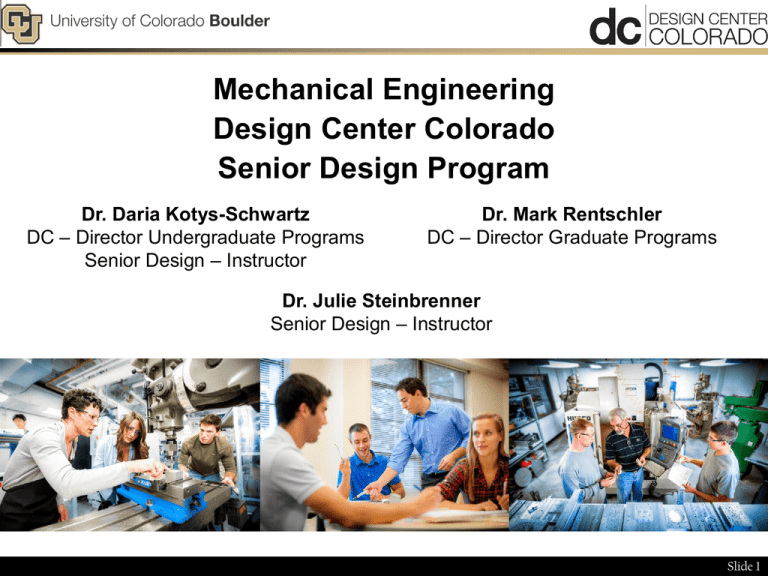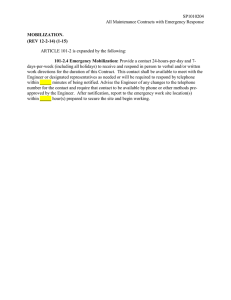Mechanical Engineering Design Center Colorado Senior Design Program
advertisement

Mechanical Engineering Design Center Colorado Senior Design Program Dr. Daria Kotys-Schwartz DC – Director Undergraduate Programs Senior Design – Instructor Dr. Mark Rentschler DC – Director Graduate Programs Dr. Julie Steinbrenner Senior Design – Instructor Slide 1 Who Are We? BY THE NUMBERS • Over 1600 student participants • 290 projects from 66 organizations since 2000 • 100% ME student participation in sponsored projects • 1500 student hours per project • 34 sponsored projects for 2015-2016 • 29 Faculty Directors for 2015-2016 Slide 2 The Role of Senior Design A Transitional Experience • Connecting the chasm between their engineering education and their career as a engineer Objectives • Develop an understanding of the necessary professional skills needed to succeed in industry (life!) • Understand how to collaboratively work in a team toward a common design • Become proficient at written technical communications • Become proficient at oral technical communications • Become proficient at managing long term projects • Become proficient at integrating technical skills to successfully complete a project Slide 3 The Role of Senior Design Objectives • Develop the knowledge and ability to use skills in heat transfer, fluid mechanics, circuits, etc. to perform engineering analysis • Generate alternative design concepts and evaluate using design requirements • Apply engineering design skills to create CAD models and drawings to build professional prototypes • Use results of engineering analysis to make decisions (engineering and business) in a methodical manner • Fabricate and test physical prototypes to help make decisions Slide 4 Senior Design Course Overview Two-Course Sequence • ME Design Project 1: Professional skills, team formation, project selection and matching, project scoping, preliminary design review, critical design review, and hardware specification/ordering • ME Design Project 2: Fabrication, assembly, testing, and design iteration Course Instructors • Oversee project solicitation, course lectures/workshops, student design facilities, faculty directors, and all academic aspects of the course Faculty Director • Primary point of contact for academic topics (schedule, deliverables, etc.) Industry Client • Primary point of contact for project goals and decisions Project Funding • $1500/team 2015-2016 Course Statistics • • Students: 186 (6 per team, generally) Projects: 28 industry/non-profit and 2 competition teams Slide 5 Senior Design Organizational Chart Client Executive Officers Dr. Daria Kotys-Schwartz (Teams 1 – 15) Dr. Julie Steinbrenner (Teams 16 – 30) Sponsoring Company/ or Individual Director Faculty Member Project Manager Communication Director Financial Manager Manufacturing Engineer Test Engineer CAD Engineer System Engineer Student 1 Student 2 Student 3 Student 4 Student 5 Student 6 Student 7 Teams meet weekly with Director and Client (sometimes in joint meeting, sometimes in two separate meetings) Teams check-in with Executive Officers once per semester and as needed Slide 6 Senior Design Deliverables ME Design Project 1 – Fall Course Deliverables • • • • • • • • Individual Project Preferences Project Bid Proposals Team Role Proposals Specification and Planning Report/Presentation Preliminary Design Review Presentation Comprehensive Design Report/Presentation End of Term Report/Presentation Manufacturing Review ME Design Project 2 – Spring Course Deliverables • • • • • • • Spring Semester Planning Report Analysis, Tolerance and Test Plan Prototype Test Results Redesign and Redesign Test Results Final Project Report Outline Final Report/Presentation Mechanical Engineering Design Expo Slide 7 Morning Meeting & Training Topics Fall: Resources Communication Technical Writing Professional Expectations Intellectual Property Customer Needs, Product Specifications Project Management Concept Generation Prototyping Conflict Resolution, Social Styles Bystander Training Negotiations Spring:Transition to Industry Elevator Pitches Job Search Tips Slide 8 Grading and Performance Evaluations • Grades are assigned according to Individual Performance Evaluations. • Students are be required to fill out a self-assessment (Four goals style) and send it to their Director. • Students meet individually with Director to discuss their performance • Performance is translated into grades by Director • Grading Guidelines: (Fall – Intern, Spring – Entry-level) • A Exceeds expectations • B Meets expectations • C/D Fails to meet expectations • F Fired Slide 9 Company Client Role • Primary point of contact for project goals and decisions • Models and establishes professional and company standards • Monitors team’s execution of the design process • Responsible for ensuring engineering team meets: • company’s project goals • Provides feedback on performance review Slide 10 Previous Projects – Micro Motion Project Overview Cruise Ship Fuel Efficiency Simulator Design and build a test stand that can demonstrate the effectiveness of the Micro Motion Fuel Consumption Solution software. Team must operate the test stand and measure the effectiveness Project Requirements • Compares the differential measurement of two meters with the proprietary software against a highly accurate reference meter • Display the % error with and without the software • Must be able to heat the fluid to 80C to simulate conditions onboard the vessel • Compact enough (with some disassembly) to travel to customer locations Slide 11 Previous Projects – Ball Aerospace Project Overview Multiuse Ground Plane Redesign Ball’s current ground plane to create a new model with decreased weight, set-up time, and technician involvement, while increasing the ground plane’s ability to interact with various antennas Selection of Project Requirements • Electrical Conductivity: Surface of the ground plane must be continuously conductive with a sheet resistance of 3-4 ohms/square • Testing: Must survive 260 3’ drops onto a concrete floor • Setup: completed setup < 30 minutes by a single technician, each component must weigh < 35 lbs • Cost: Out of house < $5000 Slide 12 Thank you! Questions? Slide 13

